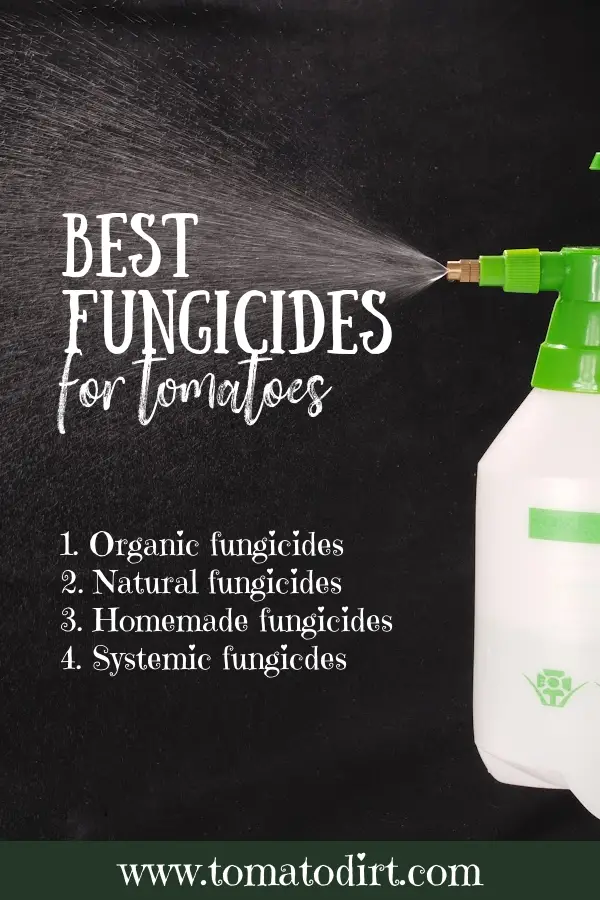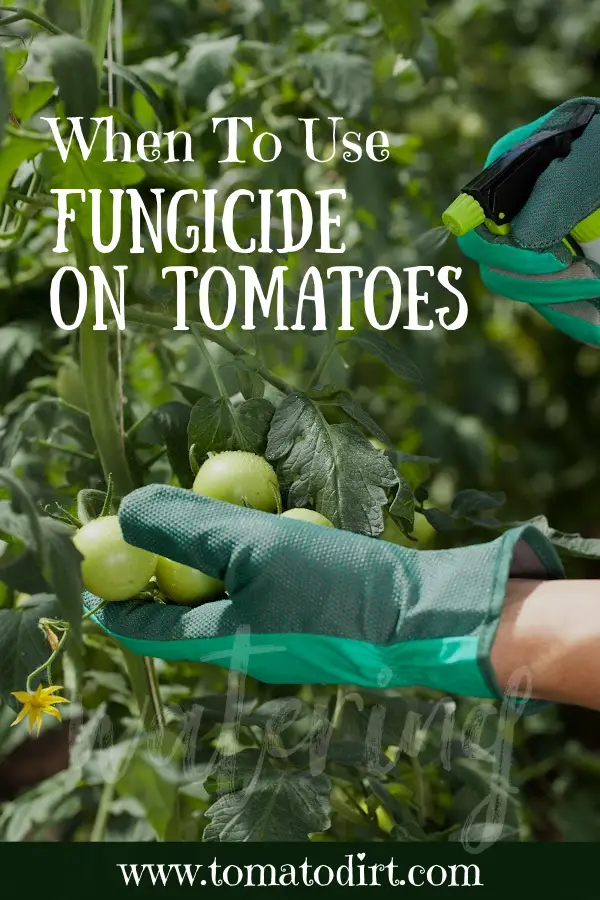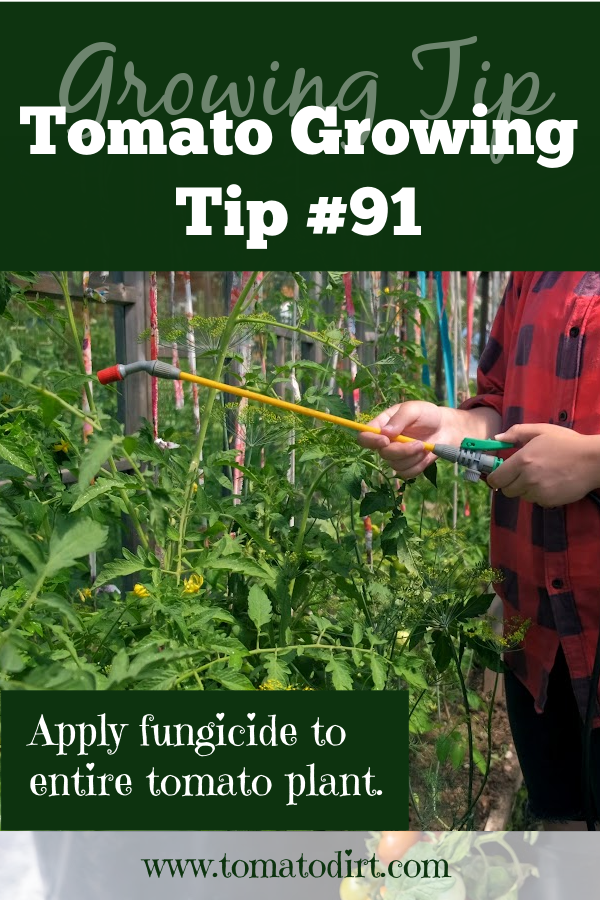FREE: 10 Must-Know Tomato Growing Tips Get The Guide
Read our affiliate disclosure here.
Fungicide for Tomatoes: A Primer
Since 2010, Tomato Dirt has garnered 4.8+ million views, making it the web’s leading online source for growing tomatoes in the home garden. Award-winning writer and Tomato Dirt owner Kathy Widenhouse has helped thousands of home gardeners grow healthier tomatoes. Be one of them when you get Tomato Dirt’s Growing Guide here.
Posted 6.16.24
Uh, oh. It’s time to break out fungicide for tomatoes, if you’ve not done so already. The leaves on your tomato plant have dark rings. Some are turning yellow – even dropping. There’s a good chance you’ve got a case of one of several tomato fungal diseases.
If there’s any good news, it’s this: the array of nasty tomato fungus types can be treated the same way: with a fungicide.
What is fungicide?
Fungicides are chemical or biological agents designed to prevent, control, or eliminate fungal infections in plants. They work by inhibiting the growth of fungi or by killing fungal spores. Fungicides can be classified into several categories based on how they act in plants, what they’re made of, and how they’re applied.
Why you need to understand fungicides
If you grow tomatoes, it’s inevitable that your plants contract one of several common fungal diseases. These nasties can cause significant damage to your plants. They’ll cause a plummet in the number of fruit your plants produce or least reduce the quality. In some cases, fungal diseases can even kill your plants.
Aside from production, fungus on tomato plants is not pretty. All those spotted, drooping leaves makes your whole garden look withered.
Without treatment, controlling fungal outbreaks can be challenging, especially in humid or wet conditions where fungi thrive. But by using a fungicide, you can manage these diseases, ensuring healthy plants and abundant harvests.
Best fungicides for tomatoes
When choosing a fungicide for your tomato plants, consider the specific disease you're targeting, the severity of the outbreak, and your preference for organic or synthetic products. Here are some of the best fungicides for tomatoes.
Organic fungicides for tomatoes
Organic fungicides are derived from natural sources and are typically less harmful to the environment and beneficial insects. Some popular organic fungicides for tomatoes include:
1. Neem oil
Neem oil is a natural extract from the neem tree that has fungicidal properties. It is effective against a wide range of fungal diseases, including powdery mildew and early blight. Neem oil works by disrupting the lifecycle of fungi and preventing spore germination.
Application schedule:
- Apply neem oil every 7-14 days.
- Start applications at the first sign of disease or as a preventive measure in early spring.
- Reapply after heavy rain.
2. Baking soda solution
A simple homemade fungicide, baking soda (sodium bicarbonate) can help control fungal diseases by creating an alkaline environment that inhibits fungal growth.
Recipe:
Mix 1 tablespoon of baking soda with 1 teaspoon of liquid soap in 1 gallon of water.
Application schedule:
- Apply the solution every 7-10 days.
- Use as a preventive measure or at the first sign of disease.
- Avoid using during the hottest part of the day to prevent leaf burn.
3. Copper fungicides
Copper fungicides are widely used to control fungal diseases on tomatoes. They are effective against a range of pathogens, including early and late blight, anthracnose, and Septoria leaf spot. Copper sulfate, for instance, is a traditional copper-based fungicide that provides broad-spectrum disease control. It works by interfering with the enzyme systems of fungi, inhibiting their growth.
Application schedule:
- Apply every 7-10 days during the growing season.
- Begin applications when plants are young and continue until the end of the season.
- Reapply after rain or irrigation.
Natural fungicides for tomatoes
Natural fungicides are products derived from plants, minerals, or other natural sources. These fungicides are often less toxic and safer for the environment.
1. Potassium bicarbonate
Similar to baking soda, potassium bicarbonate creates an alkaline environment that disrupts fungal growth. It is particularly effective against powdery mildew.
Application schedule:
- Apply every 7-14 days.
- Use as a preventive measure or at the first sign of disease.
2. Hydrogen peroxide
Hydrogen peroxide can help control fungal diseases by oxidizing the cell walls of fungi, effectively killing them.
Recipe:
Mix 1 cup of 3% hydrogen peroxide with 1 gallon of water.
Application schedule:
- Apply every 10-14 days.
- Use as a preventive measure or at the first sign of disease.
Homemade fungicides for tomatoes
Homemade fungicides can be a cost-effective and environmentally friendly way to manage fungal diseases. In addition to the baking soda solution mentioned earlier, here are a couple of other homemade options:
1. Milk spray
Milk has antifungal properties that can help control powdery
mildew and other fungal diseases.
Recipe:
Mix 1 part milk (preferably raw or unpasteurized) with 2
parts water.
Application schedule:
- Apply every 7-10 days.
- Use as a preventive measure or at the first sign of disease.
2. Garlic spray
Garlic contains sulfur compounds that have antifungal properties.
Recipe:
Crush 10-12 cloves of garlic and soak in 1 quart of water
overnight. Strain and dilute with 1 gallon of water.
Application schedule:
- Apply every 7-14 days.
- Use as a preventive measure or at the first sign of disease.
Systemic fungicides for tomatoes
Systemic fungicides are absorbed by the plant and provide internal protection against fungal diseases. They are effective for longer periods and can help control infections that are already established. Of them, azoxystrobin is a widely used systemic fungicide that provides broad-spectrum control of many fungal diseases, including early and late blight.
Application schedule:
- Apply every 14-21 days.
- Begin applications at the first sign of disease or as a preventive measure during high-risk periods.
- Follow label instructions for specific dosage and application intervals.
When to use fungicides for tomatoes
Fungicides should be used based on the disease pressure, weather conditions, and the health of your plants. Here are some guidelines to help determine when fungicides are necessary:
1. Preventive applications
- Early season: Start applying fungicides preventively in early spring, especially if you know your area is prone to certain fungal diseases. This is particularly important for diseases like early blight and late blight.
- Wet weather: Apply fungicides before periods of prolonged rain or high humidity, as these conditions favor fungal growth.
2. At the first sign of disease
- Visible symptoms: If you notice the early symptoms of fungal diseases, such as spots on leaves or fruit, start treatment immediately. Early intervention can prevent the disease from spreading and causing more damage. (See Common fungal diseases, below.)
3. High-risk periods
- Late season: As the season progresses, the risk of certain diseases increases. For example, late blight is more common in late summer and fall. Regular fungicide applications during these high-risk periods can help protect your plants and keep them from succumbing to dreaded funguses.
4. Ongoing applications
- Monitoring: Regularly inspect your plants for signs of disease. Early detection and prompt treatment are crucial.
- Sanitation: Remove and destroy infected plant material to reduce the spread of fungal spores.
Application tips and best practices
- Start early. Begin fungicide applications early in the season, especially if your area is prone to fungal diseases. Preventive treatments are often more effective than trying to control an established infection.
- Follow instructions. Always follow the manufacturer's directions for mixing and applying fungicides. Incorrect application can reduce effectiveness and harm your plants.
- Rotate fungicides. To prevent fungal resistance, rotate between different types of fungicides, especially if you need to apply them frequently.
- Cover the entire plant. Don’t just spray leaves. Fungal spores are clever and can hide anywhere on your plant. Cover all plant parts, including the undersides of leaves, stems, and fruit.
- Monitor the weather. Apply fungicides during calm weather to avoid drift and ensure good coverage. Avoid applying just before rain unless the fungicide is rain fast.
- Wear protective gear. Don’t permit exposure when you can avoid it, particularly if you’re using a chemical or synthetic fungicide. When applying fungicides, wear protective clothing, gloves, and a mask.
Common fungal diseases that respond to fungicide
If you’re aware of what to look for on your plants that may be subject to fungi, you can treat them sooner or later.
1. Early blight (Alternaria solani)
Symptoms: Dark, concentric rings on older leaves, leading to yellowing and leaf drop.
Control: Use fungicides like chlorothalonil, copper-based fungicides, or organic options such as neem oil.
2. Late blight (Phytophthora infestans)
Symptoms: Large, water-soaked lesions on leaves, stems, and fruit, often with a white mold on the underside of leaves.
Control: Apply fungicides containing chlorothalonil or copper, and systemic options like azoxystrobin can be effective.
3. Septoria Leaf Spot (Septoria lycopersici)
Symptoms: Small, circular spots with dark borders and a grayish center, leading to extensive leaf drop.
Control: Copper-based fungicides and organic options like potassium bicarbonate can help manage this disease.
4. Powdery Mildew (Leveillula taurica)
Symptoms: White, powdery spots on leaves, stems, and fruit that can cause leaves to yellow and curl.
Control: Use sulfur-based fungicides, neem oil, or homemade remedies like baking soda solutions.
5. Anthracnose (Colletotrichum spp.)
Symptoms: Small, sunken spots on ripe fruit, which can expand and cause significant rot.
Control: Copper-based fungicides and organic options like neem oil or potassium bicarbonate.
6. Fusarium Wilt (Fusarium oxysporum f. sp. lycopersici)
Symptoms: Yellowing leaves, often on one side of the plant, followed by wilting and eventual plant death.
Control: Systemic fungicides like thiophanate-methyl can be effective, but crop rotation and resistant varieties are key.
7. Verticillium Wilt (Verticillium dahliae)
Symptoms: Yellowing and wilting of lower leaves, often with V-shaped lesions.
Control: Similar to Fusarium wilt, systemic fungicides and resistant varieties are important.
Be proactive against fungal diseases
Fungal diseases can be a major challenge for tomato gardeners. But when you’re aware that fungi are lingering nearby ready to attack your plants, you can be proactive. Choose fungicide that is best for your garden and set up an application schedule to protect your tomato plants so you can enjoy healthy tomato plants and a productive growing season.
More about Tomato Plant Care
Use This 6-Step Checklist for Tomato Plant Care ...
How to choose and apply fungicide to tomato plants ...
Identifying tomato plant diseases: compare 5 kinds of tomato wilt ...
How to choose a garden sprayer that is best for you ...
Different kinds of tomato blight and how to tell them apart ...
Learn more about tomato diseases on our Pinterest board ...
Return from Fungicide for Tomatoes to Tomato Dirt home
As an Amazon Associate and Rakuten Advertising affiliate I earn from qualifying purchases.
SHARE THIS PAGE:
FREE! 10 Must-Know Tomato Growing Tips: 20-page guide
Get yours here:






